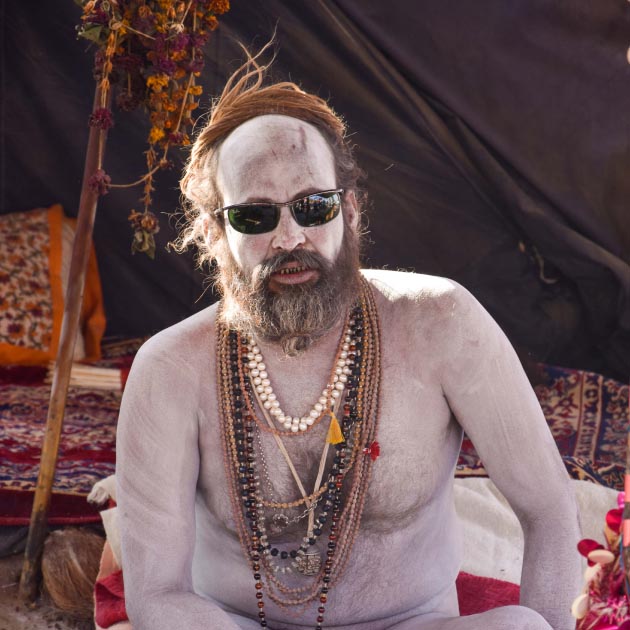The Kumbh Mela, a gathering of millions seeking spiritual rejuvenation, is graced by the presence of Sadhus and saints, ascetics who have renounced worldly pursuits in their pursuit of divine truth. These holy men play a pivotal role in the spiritual ecosystem of the Mela, embodying ancient traditions, offering guidance, and contributing to the festival’s unique atmosphere.
1. ROLES AND ATTIRE
Ascetic Renunciation:
Sadhus are individuals who have chosen a life of asceticism, renouncing material possessions and worldly desires.
Their primary focus is on spiritual practices, meditation, and the pursuit of enlightenment.
Distinct Attire:
Sadhus are easily recognizable by their distinctive attire, which may include saffron-colored robes, ash smeared on their bodies, and unique hairstyles.
Each sect of Sadhus may have its specific dress and symbols, reflecting their philosophical and religious affiliations.
2. DIVERSE SECTS
Naga Sadhus:
Among the most iconic are the Naga Sadhus, known for their nakedness symbolizing a complete detachment from material possessions.
They often lead processions during the Shahi Snan (royal bath), attracting attention with their unorthodox practices.
Vaishnava Sadhus:
Devotees of Lord Vishnu, they often wear distinctive tilak markings on their foreheads and worship deities associated with the Vaishnavism tradition.
Shaiva Sadhus:
Devotees of Lord Shiva, they smear their bodies with ash, wear Rudraksha beads, and often carry tridents (Trishuls) as symbols of their faith.
Akharas:
Sadhus are organized into different Akharas, which are spiritual orders with specific traditions and rituals.
Each Akhara has its leader and follows a particular set of practices.
3. SPIRITUAL WISDOM
Gurus and Disciples:
Sadhus often serve as spiritual guides (Gurus) for their followers (disciples), providing teachings on meditation, philosophy, and the path to enlightenment.
Disciples may live with their Gurus, learning through direct experience and oral traditions.
Discourses and Satsangs:
Sadhus deliver discourses and participate in satsangs (spiritual gatherings) where they share their wisdom and insights.
Pilgrims and seekers have the opportunity to engage in philosophical discussions and seek guidance on their spiritual journeys.
4. RITUALS AND PRACTICES
Austerities and Tapasya:
Sadhus often engage in intense austerities and tapasya (penance) to purify their minds and attain higher states of consciousness.
Some may perform rituals that involve fire ceremonies, chanting of mantras, and meditation.
Participation in Rituals:
Sadhus actively participate in the various rituals and ceremonies of the Kumbh Mela, contributing to the sanctity of the event.
Their presence is especially prominent during the Shahi Snan, where they lead the processions to the sacred rivers.
5. COMMUNITY SERVICE
Social Initiatives:
Many Sadhus are involved in social and community service, running charitable organizations, schools, and hospitals.
Their commitment to seva (selfless service) extends beyond spiritual teachings to address social issues.
6. MEETING POINTS OF TRADITIONS
Interfaith Dialogue:
Kumbh Mela becomes a melting pot of diverse spiritual traditions, and Sadhus often engage in interfaith dialogue, fostering understanding and harmony.
The exchange of ideas between different sects contributes to the spiritual unity of the Mela.
7. ICONIC FIGURES
Revered Saints:
Some Sadhus attain the status of revered saints, their life stories and teachings passed down through generations.
Pilgrims seek the blessings of these saints, believing in the transformative power of their spiritual aura.
CONCLUSION
Sadhus and saints are the spiritual custodians of the Kumbh Mela, embodying the essence of asceticism, wisdom, and devotion. Their presence infuses the Mela with a profound spiritual energy, creating an environment where seekers from all walks of life can connect with the divine and embark on their individual journeys toward self-realization. Through their teachings, rituals, and austere lifestyles, Sadhus enrich the cultural and spiritual tapestry of this timeless pilgrimage.

